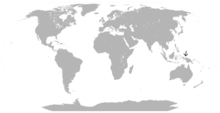| Biak gerygone | |
|---|---|
|
Scientific classification
| |
| Domain: | Eukaryota |
| Kingdom: | Animalia |
| Phylum: | Chordata |
| Class: | Aves |
| Order: | Passeriformes |
| Family: | Acanthizidae |
| Genus: | Gerygone |
| Species: | G. hypoxantha
|
| Binomial name | |
| Gerygone hypoxantha
Salvadori, 1878
| |

| |
| Synonyms | |
|
Gerygone magnirostris hypoxantha | |
The Biak gerygone (Gerygone hypoxantha) is a species of bird in the family Acanthizidae. It is endemic to the islands of Biak and Supiori in West Papua, Indonesia.
Its natural habitats are subtropical or tropical moist lowland forests and subtropical or tropical moist shrubland. It is threatened by habitat loss and is listed as vulnerable by the IUCN. [1]
It was previously treated as a subspecies of the large-billed gerygone (Gerygone magnirostris). [2]
References
- ^ a b BirdLife International (2016). "Gerygone hypoxantha". IUCN Red List of Threatened Species. 2016: e.T22704697A104067231. doi: 10.2305/IUCN.UK.2016-3.RLTS.T22704697A104067231.en. Retrieved 11 November 2021.
- ^ Gill, Frank; Donsker, David, eds. (2019). "Bristlebirds, pardalotes, Australasian warblers". World Bird List Version 9.1. International Ornithologists' Union. Retrieved 21 January 2019.
| Biak gerygone | |
|---|---|
|
Scientific classification
| |
| Domain: | Eukaryota |
| Kingdom: | Animalia |
| Phylum: | Chordata |
| Class: | Aves |
| Order: | Passeriformes |
| Family: | Acanthizidae |
| Genus: | Gerygone |
| Species: | G. hypoxantha
|
| Binomial name | |
| Gerygone hypoxantha
Salvadori, 1878
| |

| |
| Synonyms | |
|
Gerygone magnirostris hypoxantha | |
The Biak gerygone (Gerygone hypoxantha) is a species of bird in the family Acanthizidae. It is endemic to the islands of Biak and Supiori in West Papua, Indonesia.
Its natural habitats are subtropical or tropical moist lowland forests and subtropical or tropical moist shrubland. It is threatened by habitat loss and is listed as vulnerable by the IUCN. [1]
It was previously treated as a subspecies of the large-billed gerygone (Gerygone magnirostris). [2]
References
- ^ a b BirdLife International (2016). "Gerygone hypoxantha". IUCN Red List of Threatened Species. 2016: e.T22704697A104067231. doi: 10.2305/IUCN.UK.2016-3.RLTS.T22704697A104067231.en. Retrieved 11 November 2021.
- ^ Gill, Frank; Donsker, David, eds. (2019). "Bristlebirds, pardalotes, Australasian warblers". World Bird List Version 9.1. International Ornithologists' Union. Retrieved 21 January 2019.
